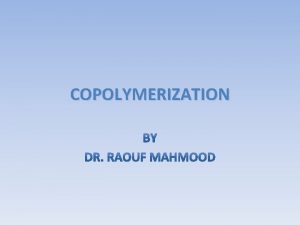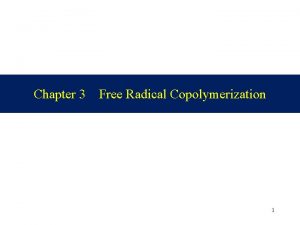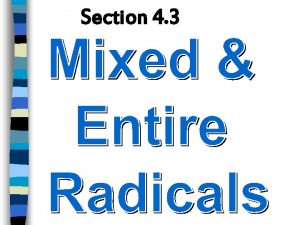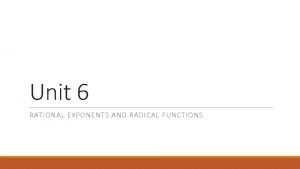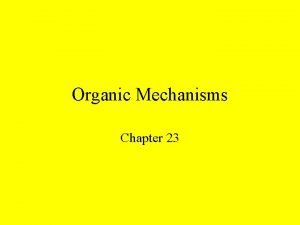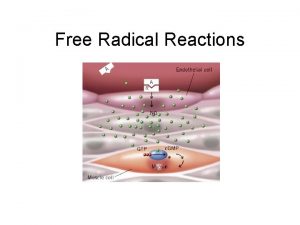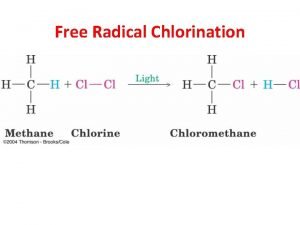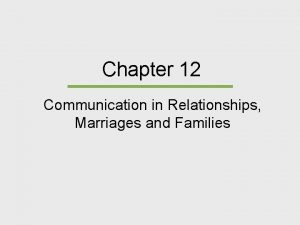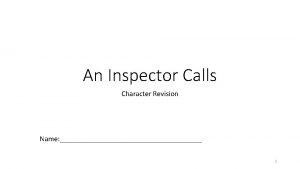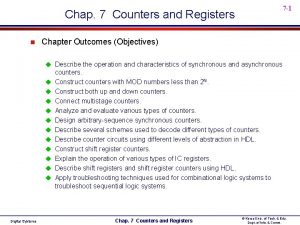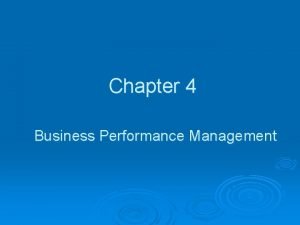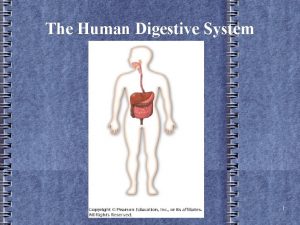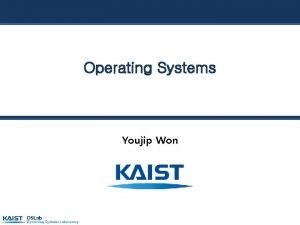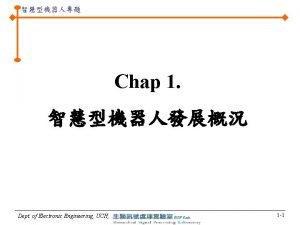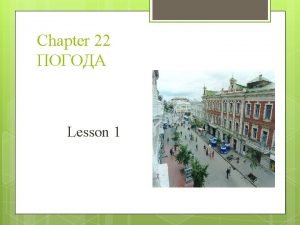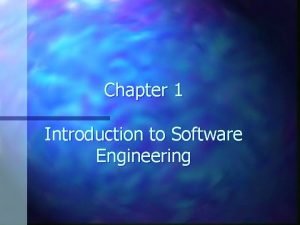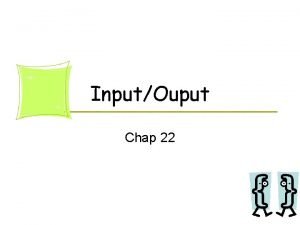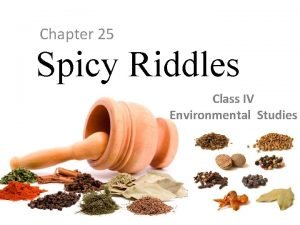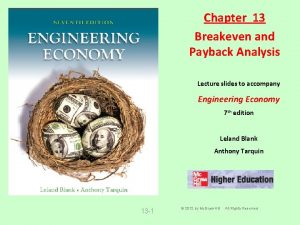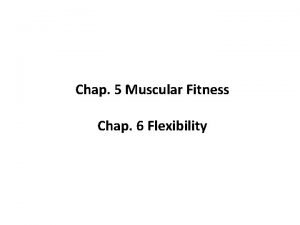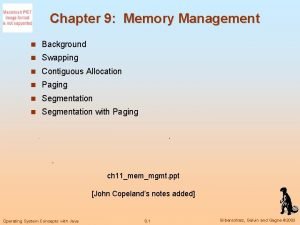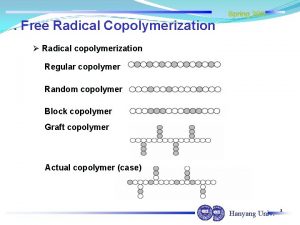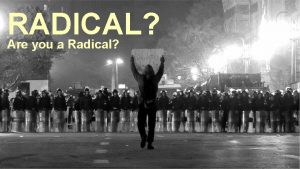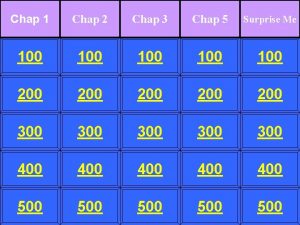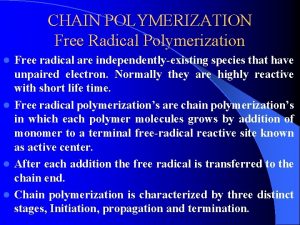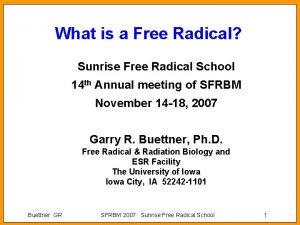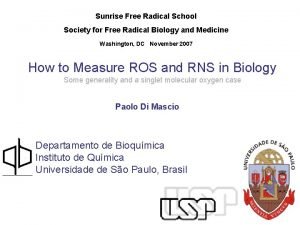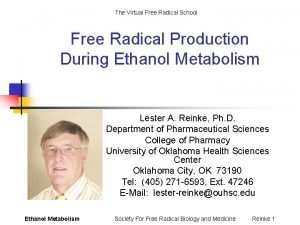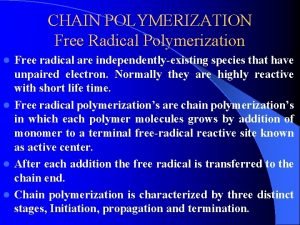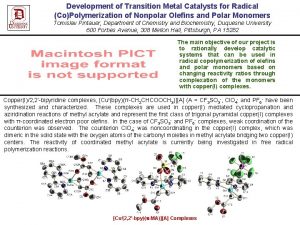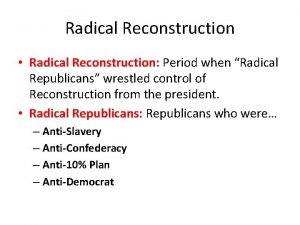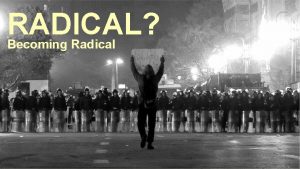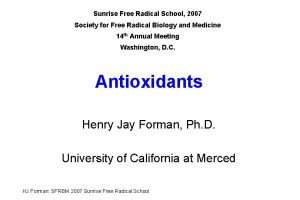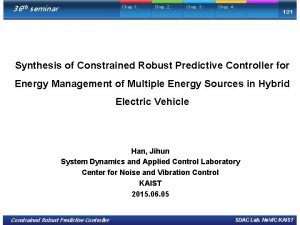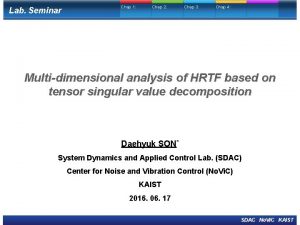Spring 2007 Chap 11 Free Radical Copolymerization Radical


































- Slides: 34

Spring 2007 Chap 11. Free Radical Copolymerization Ø Radical copolymerization Regular copolymer Random copolymer Block copolymer Graft copolymer Actual copolymer (case) Hanyang Univ. 1

Spring 2007 Chap 12. Free Radical Copolymerization Copolymer Equation Only Binary Case Two Monomers; M 1 + M 2 Steady State Assumption and chain transfer & termination compared w/ propagation ……① Hanyang Univ. 2

Spring 2007 Copolymer Equation ……② Instantaneous ratio of monomers in copolymer From ① and ② where , monomer reactivity ratio COPOLYMER EQ. Hanyang Univ. 3

Spring 2007 Meaning of r & Definition of f 1, F 1 Meaning of r characterizes the reactivity of the 1 radical with respect to the two monomers 1 and 2 then homopolymerization growth is preferred then only reaction with 2 will occur Define f 1, F 1 f 1, f 2 : mole fractions of monomers in feed From ③, ④ F 1, F 2 : mole fractions of monomers in polymer …… ③ ……⑤ how come? Homework! ……④ Hanyang Univ. 4

Ideal Copolymerization Spring 2007 Ideal Copolymerization Most ionic copolymerizations are characterizes bythe ideal type of behavior When , the two monomers show equal reactivities toward both propagatin Hanyang Univ. 5

Spring 2007 Ideal Copolymerization or One of the monomer us nire reactive than The other toward both propagating speces. The copolymer will contain a larger proportion of the more reactive monomer in random placement 1 F 1 0 f 1 Surfing to the internet For further details about Ideal Copolymerization Click next homepage. http: //www. chem. rochester. edu/~chem 421/copoly. ht m Hanyang Univ. 6

Alternating Copolymerization Spring 2007 Alternating Copolymerization or As r 1, r 2 approach to zero, alternating tendency can be observed → If If If perfect alternation! plots cross the line representing , , then become homopolymer Hanyang Univ. 7

Alternating Copolymerization Spring 2007 Mean of Cross-over Point At these crossover points the copolymer and feed compositions are the same and copolymerization occurs whthout a change in the feed composition Such copolymerizaions are termed Azeotropic copolymeriztions Condition of Azeotropic copolymeriztion and ∵ Hanyang Univ. 8

Alternating Copolymerization Spring 2007 ∴ Hanyang Univ. 9

Alternating Copolymerization Spring 2007 ( and ) Both types of propagating species preferentially add monomer M 1. there is a tendenc consecutive Homopolymerization of the two monomers. And then monomer M 2 will subsequently homopolymerize. In the result r 1 r 2=1 ideal or random fix r 2=0. 5 Addition monimer A and A* Can not prepare copolymer It’s alternating upto 0. 5, and above 0. 5 there’s no formation of copolymer Hanyang Univ. 10

Alternating Copolymerization Spring 2007 r 2=0. 5 azeotropic comp alternating r 2=0. 5 r 1=1 no azeotrope r 1, r 2 > 1 Case tend to be a block copolymerization Hanyang Univ. 11

Alternating Copolymerization Drift: r 1, r 2 > 1 r 1, r 2 <1 , finally Spring 2007 block azeotrope alternating Block COPOLYMERIZATION HW #6. Solve S. S. expression for a monomer concentration and substitute into the original composition equation which contains the active center. You can get eq. in terms of active center concentrations and if necessary define new kind of new reactivity ratio in eq. Hanyang Univ. 12

Experimental Determination of r 1 & r 2 Spring 2007 Experimental Determination of r 1 & r 2 1. Mayo and Lewis rearrange copolymer eq. and can get monomer comp copolymer comp. then vary r 1 value (put) and iterate Hanyang Univ. 13

Experimental Determination of r 1 & r 2 Spring 2007 2. Finemann and Ross Recall A B at low conversion Hanyang Univ. 14

Relationship Between ξand F 1, f 1 Spring 2007 Relationship Between ξand F 1, f 1 Material Balance for M 1 where [M] = total # of moles of monomers decrease of M 1 monomer Hanyang Univ. 15

Effect of Reaction Condition Spring 2007 Reaction medium Depend on Solubility, PH, Viscosity, Polarity Temperature But the effect of temperature on r is not large Pressure But the effect of pressure on r is not large Reactivity Next page Hanyang Univ. 16

Spring 2007 Effect of Reaction Condition Structure and Reactivity I. Resonance Stabilization II. Polar Effects III. Steric Effects I. Resonance Stabilization Substituent on Double Bond Relative Reactivity of Monomer Stabilization Energy, kcal/mole Olefine Radical -H, -OCH 3 1 0 0 -OAc, -CH 3 1. 5 -5 2. 5 4 -Cl 3 -20 - 6 -COO, -COOH 20 -60 2. 5 - -CN, -COR 30 -60 0 - 3 -4 25 -C 2 H 3, -C 6 H 5 50 -100 * Walling’s “Free Radicals in Solution” Hanyang Univ. 17

Structure and Reactivity Spring 2007 Define r. A, r. B : monomer reactivity ratios RA, RB : active center reactivity ratios Hanyang Univ. 18

Spring 2007 Structure and Reactivity TABLE I. Propagation Rate Constants, Monomer Reactivity Ratios, and Active Center Reactivity Ratios for Radical Chain-Growth Polymerizations 1 Mon A 2 Mon B 2 KAAx 10 -3 KBBx 10 -3 AN AN MA MA MA MMA STY VA STY VA VA 1. 96 2. 09 0. 515 2. 09 0. 515 0. 165 2. 30 r. A r. B 1. 26 0. 15 0. 04 5. 4 0. 25 0. 20 9. 0. 46 20 55 0. 67 1. 20 0. 40 0. 05 0 3. 22 0. 75 0. 1 0. 52 0. 01 5 0. 01 RA RB 6. 28 x 10 - 1. 34 x 100 1 3. 94 x 100 2 4. 57 x 10 4. 8 x 100 3. 4 x 10 -3 4. 3 x 10 -2 6. 3 x 100 1. 31 x 101 6. 16 x 102 9. 5 x 100 -2 9. x 10 -2 1. 6 x 101 1. x 10 1. 6 x 100 -1 3. 4 x 10 -3 1. 5 x 10 1 8. 9 x 10 7. x 10 -4 8. x 102 1 All values are based on data collected at 60℃ 2 AN=acrylonitrile; MA=methylacrylate; MMA=methylmetacrylate; STY=styrene; VA=vinyl acetate Hanyang Univ. 19

Structure and Reactivity Spring 2007 Active Center Reactivity Ratios vs. Monomer Reactivity Ratios Relative reactivity of the monomer when then when The effect in relative reactivity of the active center is more stronger than that of monomer. The monomer reactivity gets affect in opposite way comparing to the active center reactivity. Hanyang Univ. 20

Spring 2007 Structure and Reactivity Odian Table 6 -3. Relative Reactivities(1/r) of Monomers Polymer Radical Monomer Butadie ne Butadiene Sty VAc VC MMA MA AN 29 4 20 50 100 50 2. 2 5. 0 25 1. 9 67 10 2 6. 7 3. 4 20 10 1. 7 Styrene 0. 7 Methyl Metacrylate 1. 3 Methyl Vinyl Ketones 1. 7 Acrylonitrile 3. 3 2. 5 20 25 0. 82 Methyl Acrylate 1. 3 10 17 0. 52 0. 67 0. 54 10 0. 39 1. 1 0. 05 9 4. 4 0. 10 0. 25 0. 37 0. 05 0. 11 0. 24 Vinylidene Chloride Vinyl Acetate 0. 11 0. 01 9 0. 5 9 1. 2 Hanyang Univ. 21

Spring 2007 Structure and. Effects Reactivity @ Substituent Φ, CH 2=CH- > -C≡N, -COR > -COOH, -COOR > -Cl > -O-COR, -R > OR, -H monomers increase relative reactivity by resonance stabilization. The resonance stability of the monomer increases the reactivity of the monomer. The resonance stability of the radical is weakened reactivity of the Table. 6 -4 Rate Constant(k 12) for Radical-Monomer Reactions radical Polymer Radical Monomer(M 1) Butadiene Styrene Methyl _methacrylate Acrylonitrile Methyl _acrylate Vinyl chloride Vinyl acetate Buta dien e Styren e Methyl Metacrylat e Acryl Methyl o. Acrylat nirile e Vinyl Aceta te 100 70 280 165 2, 060 1, 130 330 314 413 515 422 98, 00 0 49, 00 0 230, 0 00 154, 0 00 130 11 215 9. 7 3. 4 268 52 26 13, 10 0 1, 960 41, 800 10, 045 4, 180 2, 510 2, 090 520 530 Vinyl Chlori de Q 1 e 1 319, 00 2. 39 0 1. 05 550, 00 0. 74 0 0. 60 0. 80 110, 00 0. 42 0. 40 46, 000 0 0. 04 1. 20 23, 000 225, 00 4 0. 60 22 Univ. 0. 20 0 Hanyang 0. 02 0, 100 187, 00 6 -

Spring 2007 Structure and Reactivity Resonance stabilization of Active Center Transition State Theory AB* Activated complex ΔER A+B P. E. ΔHR compound Increasing Separation of A & B Hanyang Univ. 23

Spring 2007 Structure and Reactivity AB Morse curve P. E. A+B repulsion curve Increasing Separation of A & B R P. E. ΔE 1‡ > ΔE 3‡ then Rexn III is less stable than Rexn I ΔHR 3‡ < ΔHR 1‡ ΔE 1‡ R + M Reaction I R ΔE 3‡ Rs + M Reaction III R Increasing Separation of Reactant Hanyang Univ. 24

Structure and Reactivity Spring 2007 Resonance stability of Active Center become primary Resonance stability of Monomer become secondary Hanyang Univ. 25

Spring 2007 Structure and Reactivity -ΔH ΔE‡ R·+ MS → RS· 1. 20 0. 40 R·+ M → R· 0. 95 0. 50 RS·+ MS → RS· 0. 70 RS·+ M → R· 0. 40 0. 80 |-ΔH | ① > ② > ③ > ④ ΔE‡ ④ > ③ > ② > ① Surfing to the internet For further details about Free Radical Polymerization Click next homepage. http: //www. chem. rochester. edu/~chem 421/fr full. htm Hanyang Univ. 26

Structure and Reactivity Spring 2007 II. Polar Effects Tend to cause alternation in a copolymerization i. e. for polar effects e : tendency to give monomer a polar effects (Polarity Values) Alfrey-Price Q, e scheme Hanyang Univ. 27

Structure and Reactivity @ Q-e Spring 2007 scheme of Alfred Price forecast randomness of copolymerization , As know r, prediction is possible to polar, resonance effect. Guidance to chemists where P : active center reactivity Q : monomer reactivity i, j : active center, monomer, respectively Hanyang Univ. 28

Structure and Reactivity Spring 2007 so that, this equation forecast Base materials use styrene : (arbitrary ) fair results, but not absolute in predicting r using Q-e scheme. alternating tendency is correct Hanyang Univ. 29

Spring 2007 Structure and Reactivity Active Center Reacting Ratios P-e scheme St AN MA MMA VAc P e Q E 1 58. 23 21. 03 2. 413 751. 3 -0. 8 1. 233 0. 577 0. 397 -0. 027 1 0. 42 0. 24 0. 024 -0. 8 1. 2 0. 4 -0. 22 Hanyang Univ. 30

Structure and Reactivity Spring 2007 The criticism against Q-e scheme Reference state arbitrarily set. Alternating effect was observed due to fixed charges not due to the induced dipole Exercise) How to indicate Randoness of Copolymer with Q-e scheme ? We can forecast alternation or randomness through Q-e scheme, however, why ca Blockcopolymerization? (algebraic standpoint) Surfing to the internet For further details about Free Radical Polymerization Click next homepage. http: //www. kcpc. usyd. edu. au/resources/notes/gilbert notes 3. pdf Hanyang Univ. 31

Structure and Reactivity Spring 2007 III. Steric Effects 1) 1, 2 -disubstituted ethylene do not homopolymerize readily 2). 1, 1 -disubstituted ethylene II. Polar Effects planar conformation tetrahedral conformation more reactive Hanyang Univ. 32

Structure and Reactivity Spring 2007 3) Cis-trans Effect The trans is stabilized the cis than thermodynamics(Heat of Hydrogenation) Planarity! Easier for trans than cis Steric Effect! Surfing to the internet For further details about Free Radical Polymerization Click next homepage. http: //pslc. ws/macrog/lab/unit 1. htm Hanyang Univ. 33

Spring 2007 Structure and Reactivity Table 6 -5 Rate Constants( ) for Radical-Monomer Reactionsa Monomer Polymer Radical Vinyl Acetat e Styrene Acrylonitr ile Vinyl chloride 10, 0 9. 7 725 Vinylidene chloride 00 89 2, 150 Cis-1, 223, 0 0. 79 Dichloroethylene 00 4. 5 29 Trans-1, 2365 10. 3 4. 2 Dichloroethylene 2, 32 0. 83 a Trichloroethylene 0 data in Table 3 -11 and 6 -2 and [66] values calculated from Tetrachloroethylene 3, 48 0 1, 1 -disubs. High reactive 338 Mono subs. Tri subs. Trans 1, 2 Cis 1, 2 Hanyang Univ. 34
 Chap chap slide
Chap chap slide Mayo equation
Mayo equation Azeotropic copolymerization
Azeotropic copolymerization Ideal copolymerization
Ideal copolymerization Copolymerization
Copolymerization Copolymerization
Copolymerization For chase
For chase Months of summer winter autumn and spring
Months of summer winter autumn and spring Bae yong-kyun
Bae yong-kyun Mixed radical to entire radical
Mixed radical to entire radical Entire to mixed radical
Entire to mixed radical Unit 6 radical functions homework 6 radical equations
Unit 6 radical functions homework 6 radical equations Free radical substitution mechanism
Free radical substitution mechanism Radical substitution
Radical substitution Reaction of propane with chlorine
Reaction of propane with chlorine Antioxidant free radical
Antioxidant free radical Define the relationship chapter 12
Define the relationship chapter 12 Elements of physical health
Elements of physical health I was in that state when a chap easily turns nasty analysis
I was in that state when a chap easily turns nasty analysis Chap counter
Chap counter The origin of species ch 24 manga
The origin of species ch 24 manga Chapter 1 clothing
Chapter 1 clothing Business performance chapter 4
Business performance chapter 4 Chap 23
Chap 23 Youjipp
Youjipp Chap 1
Chap 1 In the summer chap 22
In the summer chap 22 Mathew 5
Mathew 5 System engineer chap 1
System engineer chap 1 Chap 22
Chap 22 Small and round like a pearl i am black when i am whole
Small and round like a pearl i am black when i am whole Payback chapter q
Payback chapter q Fitness chap
Fitness chap Swapping ch 9
Swapping ch 9 Fitness chap 1
Fitness chap 1




